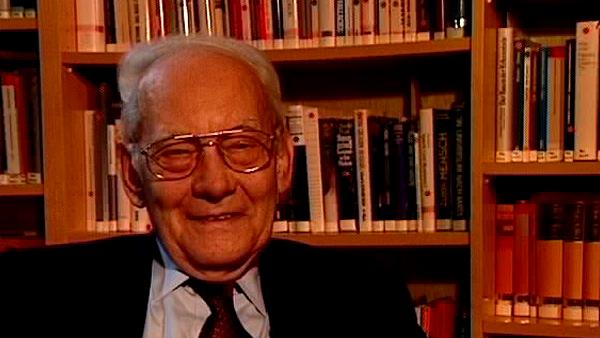NEXT STORY

Günther Strunk's true evolution experiment
RELATED STORIES

NEXT STORY

Günther Strunk's true evolution experiment
RELATED STORIES


|
Views | Duration | |
|---|---|---|---|
| 51. A nice story about quasispecies | 219 | 01:06 | |
| 52. Günther Strunk's true evolution experiment | 184 | 03:08 | |
| 53. Nature finds a way not to calculate everything in detail | 148 | 05:53 | |
| 54. A chance meeting with Francis Crick in Mainz | 229 | 01:02 | |
| 55. What does a hypercycle do? | 351 | 03:42 | |
| 56. Proving the hypercycle system | 178 | 03:49 | |
| 57. The Hypercycle - A Principle of Natural... | 1 | 262 | 01:12 |
| 58. No theory without experiments, no experiments without theory | 387 | 04:40 | |
| 59. The necessity for the theory for hypercycles | 159 | 01:46 | |
| 60. Einstein and the theory of quantum mechanics | 328 | 01:45 |


Quasispecies is a large distribution of mutants in which you have those which are very efficient, and they keep the quasispecies alive, and you have mutants which are produced by the efficient ones but themselves are very inefficient. I will show you later an example of that. So you have a big distribution of many mutants of low efficiency and a few...
[Q] Very few.
... being high efficiency, some neutrals among them as Kimura had proposed... neutrals... they really find them there. And when I talked about this quasispecies more in our winter seminar, our friend Shneior Lifson... Shneior Lifson is an Israeli scientist and older colleague of mine, a wonderful friend and has always very good stories... so I saw his eyes were... 'Shneior, what's the matter?' He said, 'Oh, now I understand why man is called Homo sapiens, although most people are stupid'. So that was a nice story in the winter seminar.
Nobel Prize winning German biophysical chemist, Manfred Eigen (1927-2019), was best known for his work on fast chemical reactions and his development of ways to accurately measure these reactions down to the nearest billionth of a second. He published over 100 papers with topics ranging from hydrogen bridges of nucleic acids to the storage of information in the central nervous system.
Title: A nice story about quasispecies
Listeners: Ruthild Winkler-Oswatitch
Ruthild Winkler-Oswatitsch is the eldest daughter of the Austrian physicist Klaus Osatitsch, an internationally renowned expert in gas dynamics, and his wife Hedwig Oswatitsch-Klabinus. She was born in the German university town of Göttingen where her father worked at the Kaiser Wilhelm Institute of Aerodynamics under Ludwig Prandtl. After World War II she was educated in Stockholm, Sweden, where her father was then a research scientist and lecturer at the Royal Institute of Technology.
In 1961 Ruthild Winkler-Oswatitsch enrolled in Chemistry at the Technical University of Vienna where she received her PhD in 1969 with a dissertation on "Fast complex reactions of alkali ions with biological membrane carriers". The experimental work for her thesis was carried out at the Max Planck Institute for Physical Chemistry in Göttingen under Manfred Eigen.
From 1971 to the present Ruthild Winkler-Oswatitsch has been working as a research scientist at the Max Planck Institute in Göttingen in the Department of Chemical Kinetics which is headed by Manfred Eigen. Her interest was first focused on an application of relaxation techniques to the study of fast biological reactions. Thereafter, she engaged in theoretical studies on molecular evolution and developed game models for representing the underlying chemical proceses. Together with Manfred Eigen she wrote the widely noted book, "Laws of the Game" (Alfred A. Knopf Inc. 1981 and Princeton University Press, 1993). Her more recent studies were concerned with comparative sequence analysis of nucleic acids in order to find out the age of the genetic code and the time course of the early evolution of life. For the last decade she has been successfully establishing industrial applications in the field of evolutionary biotechnology.
Tags: Quasispecies, mutants, Motoo Kimura, Shneior Lifson
Duration: 1 minute, 7 seconds
Date story recorded: July 1997
Date story went live: 24 January 2008